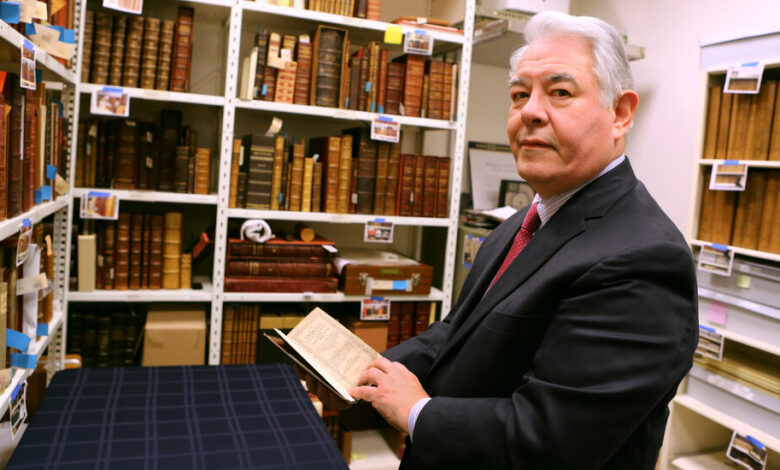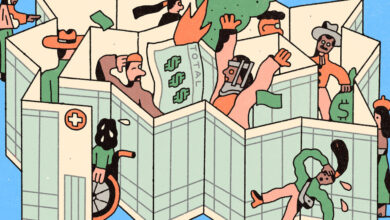David Redden, Who Brought Ingenuity to the Auction Block, Dies at 75

One hundred seventy-five cookie jars that belonged to Andy Warhol. The bat that Babe Ruth carried in his last appearance at Yankee Stadium. A piano plinked by Dooley Wilson, as Sam, in “Casablanca.” The Duchess of Windsor’s jewelry.
David N. Redden, an innovative auctioneer and a dapper presence at the podium, sold them all in a 42-year career at Sotheby’s. He also sold the Magna Carta, James Naismith’s original rules of basketball, a 1776 copy of the Declaration of Independence found behind a $4 flea-market painting, and the world’s most expensive book, stamp and coin.
Mr. Redden, who specialized in rare manuscripts, collectibles, memorabilia and celebrity bric-a-brac — and also in generating excitement around such objects, turning auctions into high entertainment — died on May 11 at his home in Cornwall-on-Hudson, N.Y. He was 75.
His wife, Jeannette Redden, said the cause was complications of amyotrophic lateral sclerosis, or A.L.S., which he had for nine years.
As a vice chairman of Sotheby’s, and as its longest-serving auctioneer, Mr. Redden had a touch of P.T. Barnum in his flair for dreaming up novel items to sell and romanticizing them with a story that attracted publicity, bidders and simply looky-loos to Sotheby’s galleries on the Upper East Side of Manhattan. He organized many of Sotheby’s most famous sales.
“David Redden had a vision for presenting things to make them larger than life,” Benjamin Doller, the chairman of Sotheby’s for the Americas, said in an interview. “He was a great auction impresario.”
As the Soviet Union collapsed in 1991, Mr. Redden traveled to Star City, Russia, and persuaded the authorities to allow a going-out-of-business sale of space artifacts. Back in New York, he auctioned a capsule, a spacesuit, moon rocks and, audaciously, a research rover left behind on the moon. (It sold for $68,500 to an anonymous buyer who wanted the bragging rights of ownership.)
“The urge to collect is not based on the age of objects,” Mr. Redden told The New York Times in 1995. “As a small child, I was a passionate collector of rocks, leaves, bark and insects. Sometimes what’s new is what people want.”
Perhaps the most famous event of his career, which he helped to organize and to gavel down, was the four-day sale in 1996 of the estate of Jacqueline Kennedy Onassis. Some 30,000 people viewed the pre-sale displays of furniture, jewelry and White House knickknacks and snapped up more than 100,000 catalogs, at $90 in hardcover and $45 in softcover.
Prices, driven by ecstasies of nostalgia, went through the roof. A rocking chair that President John F. Kennedy had used went for $453,000. Arnold Schwarzenegger paid $772,500 for the president’s MacGregor golf clubs. A leather desk set sold for $189,500.
“They are not selling things,” the Times columnist Clyde Haberman wrote. “They are selling yesterday, when the world was young.”
Mr. Redden brought objects to the auction block that had never traded hands in such a setting. In the early 1990s, while at breakfast, he read a newspaper article about a legal dispute over an exquisitely preserved Tyrannosaurus rex named Sue that had been dug up in South Dakota.
“He said to me, ‘It should go to auction,’” Ms. Redden, his wife, recalled. “I said, ‘Why don’t you just call them up?’” He was in his pajamas, but he did. He got the dinosaur man, and they sold it for $8 million.”
Mr. Redden was also a pioneer of internet auctions for Sotheby’s. On its website, Sothebys.com, he auctioned the flea market Declaration of Independence in 2000 for $7.4 million, one of the highest prices paid for a document on the internet to that point. The buyers were the television producer Norman Lear and David Hayden, a tech entrepreneur.
David Normand Redden was born on Jan. 23, 1949, in Canton, China (now Guangzhou), to Normand and Annabel (Austin) Redden. His father was an American diplomat, and when the Communists took over China later that year, the family escaped by boat down the Pearl River.
“We were fired on as we left,” David Redden told The Times in 2000.
As his father moved from country to country for the State Department, David attended grade school in England and secondary school in Rome. (He would retain an English accent from his schooling throughout his life.) He earned a B.A. from Wesleyan University in Connecticut, where he studied art history.
In 1974 he got a job as a catalog trainee at Sotheby’s. Six years later he was running PB-84, a spinoff of the auction house that sold lower-price art and antiques.
“I became an auctioneer very quickly in a way that wouldn’t happen nowadays: I was told to go up to the podium and get going,” he said in 2000. “I was terrified, so terrified I forgot to write down the sale prices of the first 20 lots I sold.”
In 1978 he married Jeannette Andreasen, an environmentalist. In addition to their home on Storm King Mountain in the Hudson Valley, the couple resided in a duplex in the former Joseph Pulitzer mansion on East 73rd Street, where they held dinner parties for 14 in the theatrical setting of the rooftop terrace. The apartment had once been occupied by Roy Chapman Andrews, an explorer who was also the director of the American Museum of Natural History.
Besides his wife, Mr. Redden is survived by a son, Stephen; a daughter, Clare Redden; a brother, Nigel Redden; and a sister, Melanie Redden Whitlock.
In his later years, as A.L.S. limited his mobility, his control of his muscles and his ability to speak, Mr. Redden sought ways to adapt. He communicated by typing on a computer that tracked his eye movements. He had an experimental implant in his brain and underwent intensive training aimed at enabling him to control a computer using his thoughts.
“He was always restless and looking for interesting new adventures,” Ms. Redden said. “You were not bored with him.”



